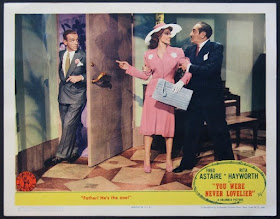 His eldest daughter now married, Edwardo Acuna (Adolphe Menjou) requires - per family tradition - that his next daughter, Maria (Rita Hayworth) will be the next to wed. Maria, however, is in no hurry to tie the knot, much to the consternation of her younger, engaged sisters, Cecy (Leslie Brooks) and Lita (Adele Mara). To tempt her towards marriage, Edwardo devises a plan - he sends her love letters and orchids every day, intending that she'll pick out some local man (of whom Edwardo approves, of course) as the wooer. But when dancer Robert Davis (Fred Astaire) is unintentionally asked to deliver the day's orchids, Maria sees him and decides HE is the suitor - and she is pleased. Her father however is not. This week we're discussing You Were Never Lovelier (1942).
His eldest daughter now married, Edwardo Acuna (Adolphe Menjou) requires - per family tradition - that his next daughter, Maria (Rita Hayworth) will be the next to wed. Maria, however, is in no hurry to tie the knot, much to the consternation of her younger, engaged sisters, Cecy (Leslie Brooks) and Lita (Adele Mara). To tempt her towards marriage, Edwardo devises a plan - he sends her love letters and orchids every day, intending that she'll pick out some local man (of whom Edwardo approves, of course) as the wooer. But when dancer Robert Davis (Fred Astaire) is unintentionally asked to deliver the day's orchids, Maria sees him and decides HE is the suitor - and she is pleased. Her father however is not. This week we're discussing You Were Never Lovelier (1942).This is by no means a great film; as a story, it's in fact, rather lame. The plot is silly, and at times feels like the authors were trying to stretch it out to full movie length. But this is not a movie that you watch for the story - when the plot starts, you wait for the next dance routine, because they are well worth the wait.
It's been said that Fred Astaire praised Rita Hayworth as "the first natural dancer he had worked with since his sister, Adele, had retired" and his favorite screen dancing partner (Puttin' On the Ritz: Fred Astaire and the Fine Art of Panache: A Biography by Peter Levinson). Mr. Astaire was an admirer of Ms. Hayworth's father, the dancer Eduardo Cansino, but had concerns that Ms. Hayworth - at 5"7' - would be too tall a partner for him (he was 5"9') when she put on her heels (TCM article). She was also 20 years his junior. However, once they began dancing, he was convinced. She's amazing in beautiful numbers like "I'm Old-Fashioned" and novelty routines like "The Shorty George." As was usually the case, she was not permitted to do her own singing; Nan Wynn provided the vocals as she had done on other Hayworth films (Being Rita Hayworth: Labor, Identity, and Hollywood Stardom by Adrienne L. McLean). This was their second - and last - film together (the other was You'll Never Get Rich).
It's apparent that Adolphe Menjou's character is supposed to be funny, but after awhile, he is just an idiot. It's no reflection on the actor - he does what he can with the part he is given, but he's not been given all that much with which to work. His attempt to convince his daughter to marry by sending her orchids and love letters is rather creepy (it might not have been in 1942, but it is now). When his wife, Delfina (Barbara Brown) begins to suspect that he is carrying on an affair with her best friend (Isobel Elsom as Maria Castro), it's all too much. Plus, no one is dancing in these scenes.
Gus Schilling (Fernando) was a burlesque performer who came to the attention of Orson Welles, and essentially became part of his film stock company. He would ultimately appear in five of Mr. Welles films (Citizen Kane, The Magnificent Ambersons, The Lady from Shanghai, Macbeth and Touch of Evil). Mr. Schilling is amusing as Acuna's abused secretary, but he doesn't have a whole lot to do except be exasperated. Similarly, the noted Latin band leader, Xavier Cugat (playing himself) has a relatively minor part - he functions as a means of getting Robert introduced to the Acuna family. Throughout his film career, Mr. Cugat would generally play himself, or an unnamed band leader. Married five times, most notably to Abbe Lane (who was one of his band singers) and to Charo (who also appeared with the band. Charo is a classically trained flamenco guitarist. Another guitarist who worked for the Cugat band was Desi Arnez), Mr. Cugat died in 1990, at the age of 90.
By the 1940s, with the War in Europe already started, Franklin Roosevelt was aware that the U.S. would probably be drawn into it. He was determined that the U.S.'s neighbors in South America not support the Axis nations, so he began a goodwill campaign that would eventually involve filmmakers like Walt Disney and Orson Welles. Latin American films became quite popular, as did performers such as Carmen Miranda. It's likely that this films setting reflects some of that interest. The original working titles of the film, Carnival in Rio and The Gay Senorita (AFI Catalog), emphasize the Latin American influences.
The New York Times review by Bosley Crowther found the film worth watching for the musical numbers, and we agree. With gowns by Irene, and choreography by Fred Astaire (and Nicanor Molinare, both of whom were uncredited), watch this for the dancing and for delightful songs like "Dearly Beloved", with music by Johnny Mercer and lyrics by Jerome Kern (the song was nominated for an Oscar). We will end with the dancing scene that we promised: "I'm Old-Fashioned" (by Mercer and Kern). Skip the plot, listen to the music and watch some really impressive dance routines by two masters.




Well,they WERE never lovelier. Truth in advertising
ReplyDelete